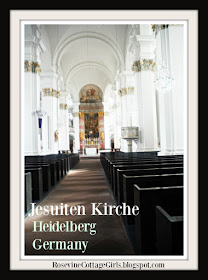 Welcome back! This time we will visit three churches and a bridge. The first church is Heiliggeistkirche also know as the "The Church of the Holy Spirit". This is the most famous church in Heidelberg.
Welcome back! This time we will visit three churches and a bridge. The first church is Heiliggeistkirche also know as the "The Church of the Holy Spirit". This is the most famous church in Heidelberg. The church stands in the middle of the market place in the old center of town. The church was first mentioned in a manuscript in 1239.
This church is the third building on this site, the current churches foundation was laid in 1398 on top of a Romanesque basilica which was erected in the place of an even older church. The construction lasted for about 150 years.
Related Post: Our Tour of Heidelberg Germany
 |
| Click photo to purchase print |
The Choir was consecrated in 1411 and the nave was finished in 1441. The work was interrupted until 1508 and the tower was finished in 1544.
In 1709 during the War of the Palatinian Succession, the church was set on fire by the French. The fire destroyed the tombs of the Palatinate electors also.
It was rebuilt and a baroque spire was added.
Today the tomb of Prince-Elector Rupert III, the church founder, is still preserved.
 |
| To purchase this photo click the picture |
The Palatine Library, the Bibliotheca Palatina, was first kept here until the 30 Years War, when Maximilian I, Elector of Bavaria took the collection and presented them to the Pope. Of the approximately 5000 books and 3524 manuscripts taken, only 885 were eventually returned in 1816. The rest are in the Vatican Library.
In the course of its history, the church was used by both Catholics and Protestants. In 1706 a partition was used so that both congregations could hold services without any mutual disturbance. The wall was removed in 1936 and the church is now used by the Protestants.
Related Posts: Come over and check out our great travel articles here
 |
| Click photo to purchase print |
In 1540 Pope Paul III officially commissioned and sanctioned the group. The building of the church started in 1712 and after the death of Elector Johann Wilhelm in 1717 the construction was halted. The construction started back up in 1749 and finished 1759. It was built in the Baroque style. The neo-baroque tower was added between 1868 and 1872.
After the Jesuit Order was abolished in 1773, the church was used by the Lazarists and then used for secular purposes. From 1793 to 1797 the church was as a hospital during the first coalition war. It was also used as a hospital during the Napoleonic War until 1808.
RELATED POST: Frankfurt Germany Saint Bartholomew's Cathedral
Today it is the main church of the Roman Catholic Church.The third church I visited was the Providenzkirche or the Providence Church. The Providenzkirche is a Protestant Church on the main street in the old town area. It was the church of the Lutheran congregation until 1821 when the church union happened combining the Lutheran and the Reformed congregations.
The Providenzkirche was built between 1659 and 1661. It stands on the grounds of the former electoral court garden. The church was named after the motto of Elector Karl Ludwig which was "Dominus providebif" which means "The Lord will provide".
 |
In 1693 the church was destroyed by the great city fire of the Palatinate War of Succession. The rebuilding started in 1715 and completed in 1721. From 1878 till 1885 the interior was completely redone.
 |
| Click picture to purchase print |
The final stop is the Karl Theodor Bridge also known as the Old Bridge. It is a stone bridge crossing the Neckar River. The current bridge is made of Neckar Valley Sandstone and is the ninth bridge built at this site, was constructed in 1788.
Since the 13th century, there have been 8 bridges built on the site. The current bridge is built on their foundations. The bridge gate at the south end of the bridge also dates back to the Middle Ages. The first bridge was built by the Romans in the First Century.
 |
| Click photo to purchase print |
This wooden pile bridge was rebuilt in stone around the 200 AD. After the collapse of this bridge, Heidelberg was without a bridge for nearly a thousand years.
The next we hear mention of a bridge is in 1284. The third bridge was destroyed in 1288 by an ice floe, while the fourth came to the same fate in 1308. The fifth also had the same fate in 1340, the sixth around 1400 and the seventh in 1470.
 |
| Click photo to purchase print |
Until next we meet again be Blessed.
End of log.




Hello, I enjoy reading through your post. I wanted to write a little
ReplyDeletecomment to support you.